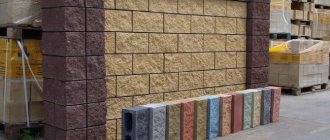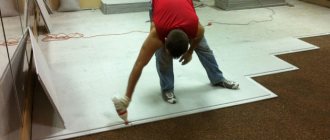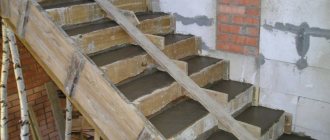Is a traditional concrete mixer always better than a hand mixer for mixing mortar, or is it better to get by with a regular hammer drill with an attachment? The issue is considered in the context of preparing mortar for masonry and leveling floor screed.
To prepare concrete for a foundation, a more or less decent garage, a bathhouse, and even more so, a residential building, there is only one correct approach - to order certified reinforced concrete concrete, with all the necessary additives. Naturally, we do not consider the intention of mixing coarse concrete with a hand mixer.
First of all, to answer this question, you need to decide what you are going to do. What amount of work needs to be done and most importantly, what kind of mixture you want to prepare.
Mixing concrete with an electric mixer: features and operating techniques
Everyone who builds a house on their own, without hired workers, wants to simplify the task for themselves. For example, use a concrete mixer to mix concrete. A high-quality concrete mixer is not a cheap pleasure. Many will say that its price will be recouped during the construction season. But I want to save money and not break my back mixing concrete with a shovel. This is where the idea comes - to use an electric mixer to mix the solution of sand, cement and crushed stone.
OtherNickFORUMHOUSE Member
I saw a video on YouTube - a man, alone, using a two-spindle mixer, mixed concrete and poured a strip foundation in two days. I thought maybe this was an advertisement for a tool? The builder claims that it is more convenient to knead with a mixer than with a concrete mixer. The question is relevant for me. I mixed concrete in a concrete mixer. It's hard for one. We have to lift buckets. Load the pear. I rented a concrete mixer. There is nowhere to store yours. And with a mixer you can knead the concrete right at the pouring site. It weighs a little. Tell me, is this realistic if you knead small volumes? Maybe someone has already used a mixer? Will the tool break?
beutiflet FORUMHOUSE Member
I think tools should be used strictly for their intended purpose. A mixer is needed to mix plaster and adhesive mixtures, and a concrete mixer is needed for concrete. The weak point of the mixer is the attachments. On heavy concrete with crushed stone, the rim's blades may come off or it will bend.
Just Grandfather FORUMHOUSE Member
Compare the price of a normal mixer and a concrete mixer. The difference is small. It seems to me that health is more important! Using a concrete mixer, you can work together. One carries sand and crushed stone, the second monitors the batch. You work alone as a mixer. Oh, what strength is needed for this. You'll get tired quickly. My concrete mixer is already 10 years old, and it has long since paid for itself.
Now let’s listen to the opinion of those FORUMHOUSE participants who actually kneaded concrete with a mixer.
Bath1
I poured the strip foundation for the fence using a mixer. Tape length 25 m. Section – 200x300 mm. I also concreted a 5 m lintel under the gate and wicket. From my own experience, I will say that you get more tired not from working with a mixer, but from throwing sand, cement and crushed stone, and pulling out concrete. But you also need to throw ingredients into the concrete mixer. It still needs to be washed later, but the mixer spun in the water and went home. Of course, I wouldn’t dare to pour a foundation for a house with a mixer, but for small volumes, it’s quite a suitable option.
The Bath1 mixture was prepared as follows:
- First he mixed dry sand and cement.
- Then he added water. The consistency of the mixture is like sour cream.
- Then he threw in 3 buckets of crushed stone. Stirred the mixture. Then I added another 1.5 buckets of crushed stone.
CartmanSr
I mixed concrete in a cast iron bath with a two-spindle mixer. Two spindles are better than one. The torque is damped and, in the case of a wedge, will not wrap around the tool. I threw cement, sand, crushed stone of fraction 5-20. I stirred for ten minutes and 200 liters of the mixture was ready. I won’t say it’s easy, but it’s not hard either. The crushed stone between the augers did not jam. The tool didn't break.
OtherNick
Briefly speaking. I listened to everyone and also decided to knead concrete with a mixer. I'm reporting. I mixed about 1.5 cubic meters of concrete for the columnar foundation. The mixture is hard. Proportions: 1 part cement, 3 parts sand, 4 parts crushed stone and 0.75 liters of water. Mixed in a 100 liter trough. I made 5-7 batches per day. I couldn't do it anymore. Your arms, especially your hands, get very tired. I’m not saying that I’m weak, but the twisting load on my joints is decent. Crushed stone of fraction 5-20 did not get stuck between the rims. The instrument also held up. Verdict: the method is suitable for small volumes for one-time work.
I wonder if it is possible to fill larger volumes using a mixer? The construction experience of FORUMHOUSE users says: “Yes.”
Veter753
My assistants and I poured 4 cubes of concrete with a mixer. There were 4 people working - two men and two women. The women put cement and enriched sand and gravel mixture into buckets. One man is kneading. The second one carries the buckets, and then the two of us dump the mixture into the formwork. Mix proportions: 1 bucket of cement, 1 bucket of sand, 3 buckets of OPGS, 0.7 buckets of water. In total, we made 115 batches with smoke breaks. It was still raining. The old tub was also leaking. They repaired it. As a result: started at 10 am, finished at eleven o'clock in the evening. Then they added a little more in the morning. The back gets tired, but if you get used to holding the mixer without bending over, with your legs spread wide apart, there is no fatigue. If they started to interfere at 7 am, there were 3 men, not women, it didn’t rain, and the tub didn’t leak, then I think they would have finished it before 6 pm. The mixer kneads the mixture quickly. The main fatigue comes from dragging buckets with OPGS through the formwork and lifting the bucket to the level of the formwork to dump the concrete.
Veter753 tips for using a mixer when mixing concrete:
- First load water, cement and sand.
- Knead the mixture until it becomes sour cream.
- Add 2 buckets of OPGS.
- Stir the mixture until it is a uniform gray color.
- Add another bucket of OPGS.
- Stir evenly again.
The concrete is ready.
If you keep the mixer in one place, it will not mix the mixture, because it will mix in one place. To mix the concrete well, you need to move the mixer in a circle, and zigzag, left and right.
Valeron 1983
The two of us, in 4 days, poured 17 cubic meters of concrete with a mixer. Monolithic slab. Concrete was mixed in a bathtub. They placed it on the reinforcement inside the formwork and turned it over after each batch. We were tired, of course, but we would have been tired with a concrete mixer too. I liked working as a mixer. It gets in the way quickly. He doesn’t twist his arms, his back doesn’t hurt, even though they kneaded with a single-spindle tool. You get more tired of carrying sand, cement and crushed stone.
The main advantages of a mixer for preparing mixtures
Carrying out work with cement mortars can take more than one hour, or even a day. At home, it is common to use a trough and shovel to prepare the mixture. This method has a lot of advantages, including the ability to control the process, but there are more disadvantages, and they are significant: starting with physical fatigue and ending with a large amount of time spent on kneading.
Each mixing tool has its own pros and cons. The choice largely depends on the volume of work to be done and the type of mixture being prepared. The use of a concrete mixer is relevant in cases where the volume of work is quite large: garden paths, strip or column foundations need to be poured. In addition, such equipment can help in situations where the solution must be prepared continuously. The concrete mixer effectively copes with liquid bulk mixtures and concrete with large fractions, crushed stone or gravel. However, a powerful construction mixer is quite capable of replacing even such advanced equipment. This is due to the design features of the attachments and the wide technical functionality of the tool.
A construction mixer is used by craftsmen to produce mortar in smaller volumes. This is also due to the fact that such a tool is convenient to use indoors during the production of viscous and plastic mixtures.
Even the most ordinary manual construction mixer is free from the disadvantages that are inherent in many concrete mixers. Bulky equipment for producing mixtures is inconvenient to clean from adhering substances: during operation, you have to drain a large amount of dirty water. In addition, concrete mixers are designed for strictly defined proportions, since the quality of the resulting solution suffers from too much or too little volume.
A construction mixer for concrete speeds up the process of producing the substance, does not take up much space during transportation and is easy to clean. This tool is much more affordable than a concrete mixer. Moreover, such a device can be an excellent assistant in finishing work when interacting with paint and varnish compositions.
Mixing concrete with a concrete mixer and a mixer: similarities and differences
Alexander651 FORUMHOUSE user
I'm interested: the concrete mixer bulb rotates at 30 rpm, and the mixer produces up to 600 rpm. Does this somehow affect the quality of the mixture?
NOnono__13FORUMHOUSE user
Despite the difference in the number of revolutions of the units, the output you will get is concrete of high quality. The main difference is that with a gravity concrete mixer the pear with the mixture rotates, but when working with a mixer, on the contrary, the container is stationary, and mixing is carried out by a rotating crown. Why are the speeds of a concrete mixer and a mixer different? If you increase the speed of the pear, then under the influence of centrifugal force, the ingredients will simply stick to the walls of the drum, and there will be no mixing process. If, on the contrary, you reduce the speed, the ingredients will slide along the lowest plane of the pear, practically without rising up. There will be no mixing process. Therefore, 25-30 rpm is optimal for a concrete mixer. If you increase the speed of the mixer, the mixture will splash out of the container. If you lower the speed, you will have to stir the mixture for a very long time.
StrawBaleFORUMHOUSE User
One more thing. It is difficult to mix the so-called in a concrete mixer. hard concrete with a low water-cement ratio. Such concrete is mixed in forced mixers, which are expensive, or, alternatively, with a mixer.
hazel grouse203FORUMHOUSE user
I mix heavy concrete with a mixer. I work alone, so I’ve already developed the optimal technique. The tool is a mixer with a power of 1.4 kW. Two spindles. I mix concrete in an 80-liter round plastic tub. This is the optimal volume. If you take more, it’s a no-brainer. Don’t chase too much volume at once! I mix 1-2-4 10 liter buckets per batch. Compared to a concrete mixer, the laying speed has almost doubled. And one more thing: the stirrer rims, depending on the configuration, can row the solution either up or down. For concrete, buy a whisk so that it will row up and you will be pulled down. It’s more convenient to work this way than trying to push the mixer through the concrete. By the way, my back doesn’t hurt, my arms don’t twist.
How does a construction mixer work?
The operating principle of a mortar mixer and a conventional drill are approximately the same, but these tools are designed for different purposes. To mix concrete, craftsmen use attachments and whisks designed to work with certain compounds.
The attachment and whisk for a construction mixer are selected based on the type of mixture and the volume of work performed:
- spiral-shaped for mixing elastic, viscous, light or dense mixtures;
- screw for working with paints and varnishes;
- cross-shaped for mixing adhesive bases, sealants and filling compounds.
In addition to differences in purpose, mixer attachments are attached in one of three ways:
- screwed directly into the mixer hole;
- connected using a fixing element;
- are secured with special clamps in the tool chuck.
All construction mixers for preparing mixtures have a similar design. Electric tools are equipped with a shock-resistant housing with a drive, motor and gearbox, as well as a mechanism for fixing the attachment. When the device is turned on, the engine engages the working element and dissimilar components are mixed to obtain a mixture. Modern models are equipped with convenient on and off buttons, as well as a shaft rotation speed controller. This allows the tool to operate in one of two modes - high or low speed.
In some models there is no gearbox, then the mixing speed directly depends on the force of pressing the button. The stronger the pressure, the more revolutions the spindle gains.
Based on their design, kneading tools are also divided into two types: drills and classic mixers. A distinctive feature of models of the first category is the presence of a jaw chuck, which reliably fixes the nozzles for mixing compositions. The drill mixer is a low-speed tool and will not replace a conventional electric drill in terms of power.
Nevertheless, such a device is useful in construction and repair work, because the combination of low speeds and high torque allows you to mix any compositions, including sand-gravel or cement, as well as drill small holes.
An electric construction mixer is considered by craftsmen to be a highly specialized tool, since its purpose is limited only to the production of mixtures. Models in this category differ in technical capabilities, and the most advanced and powerful of them can even replace a concrete mixer. These tools are
single-spindle , in which you can install only one attachment, and double-spindle , with the ability to use two whisks at once.
The devices also differ in terms of power.
The ability to reach a high speed of revolutions directly depends on this characteristic. ,
for home use it is enough to buy an electric construction mixer with a power of 1010 to 1400 W. Such models are equipped with the ability to regulate the speed; at this value, the devices can reach 850 rpm. An electric construction mixer with similar characteristics effectively copes with light and concrete mixtures.
When to start construction
The period for the start of construction can be spring (late February-early March), as well as summer - July-August. It is better to order all the necessary materials at prices lower than summer ones at the end of February in order to immediately start pouring concrete. This will save time and money by completing the construction of a country house in a shorter time.
It is important to think in advance about a method that allows you to prepare high-quality concrete. This could be a concrete mixer or mixer, which is better to rent than to purchase for short-term construction. After the mixing is completed, the concrete mixer may no longer be needed, and the money for the purchase of the unit will no longer be returned. The concrete mixer requires careful maintenance, otherwise it will not be suitable for use if it is dirty .
Conclusion:
By the way, mixer attachments can be left-handed or right-handed, capable of either lifting the mixture from the bottom of the container, or vice versa, lowering it to the bottom; the second option is preferable since it eliminates splashing. We use MD1-11E-003I, which, as it turns out, was designed for mixing paints and light solutions. Let's mix everything up! It does not affect performance in any way, but in terms of convenience it is irreplaceable.
The presence of a speed controller gives a huge advantage to the quality of the prepared mixture; increasing the speed at the final stage of mixing makes the solution more plastic.
For a concrete mixer, this option is not available.
As a class, small concrete mixers up to 150 liters are only suitable for leisurely masonry work or preparing plaster mortar, and then at a stretch, solely for their aesthetic pleasure.
To mix concrete under the foundation, due to its low productivity and its quality, using a small concrete mixer is ineffective and inconvenient. Unless in case of a hopeless situation, when it is impossible for an automixer to deliver concrete to the site.
The answer to the question which is better: a mixer or a concrete mixer, will be a mixer! Both in terms of ease of use and maintenance.
Storage is a separate matter. After completing the work, it was necessary to store the completely unpresentable colossus somewhere, now there is no such problem!
And no honest, tangible increase in productivity from a small concrete mixer was noticed.
In favor of the Fiolent MD1-11E , you can add the ability to work as a pit drill. To do this, it is enough to purchase a ready-made drill with a diameter of 160 mm and a special frame.
Source
What brand of mixers is popular among masters?
The modern market offers a wide variety of models for making mixtures from different manufacturers. As a rule, craftsmen trust brands that have already earned popularity. For example, each construction mixer Zubr boasts a large number of positive reviews. Models of this brand are distinguished by high technical characteristics, reliability and convenience. For each branded construction mixer, reviews are provided not only by experienced specialists, but also by amateurs. Among the advantages of the tool are the ability to start smoothly and gradually increase speed. Zubr mixers also feature an ergonomic design that provides a comfortable grip. But the models of this manufacturer also have disadvantages. The disadvantages include the large weight of the instruments - up to 10 kg.
Nevertheless, reviews for each construction mixer Zubr are mostly positive. The most powerful models are able to replace a more bulky concrete mixer, which requires careful maintenance.
Where to buy a construction mixer? The Valles online store offers a wide range of tools for preparing mixtures. You can buy a construction mixer for concrete at the most affordable price on the website or by calling +7. Delivery is valid throughout the Krasnodar Territory and other regions of Russia.
Types of hand-held devices
If you want to purchase a tool for use at home to solve simple problems, then it is better to opt for mixers with a power of less than a thousand watts. If you are planning to carry out large-scale construction finishing or repair work, then it is advisable to purchase equipment with a power of more than a thousand watts.
Light mixtures, for example, paint or glue mixtures, are made using a less powerful device. In such cases, attention should be paid to the rotation of the nozzles. Manufacturers offer models that can operate in different speed modes. For such tasks, it is recommended to purchase a mixer that allows you to make different batches of the required density.
Return to contents











